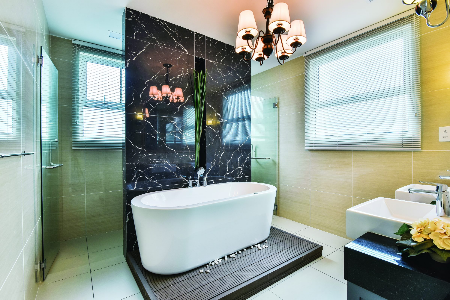If you find yourself bewildered at the range of tiles presented in your local showroom, this guide will be your rock.
Whether you are starting out with a bare cement floor, or you are faced with an aging bathroom in need of an update, there is a wide range of things that can be done with just tiles. While the default option of decking the entire bathroom in white stone may seem like the most practical choice for a clean appearance, there would be some missed opportunities for creating a unique décor in a space that most people would not expect to find a memorable interior.
 Interior design by: Nice-Style Refurbishment
Interior design by: Nice-Style Refurbishment
In pursuit of providing you with some inspiration, we took on the task of analysing the art and science of tiling: from the selection of tiles on the bases of shade, shape, texture, and size, to the installation of tiles in different orientations, arrangements, patterns, and locations. Before settling on your choice of tiles, take a look at the following ten ways of enhancing your bathroom for some ideas.
The Rule of Threes
 Interior design by: GI Design
Interior design by: GI Design
As a general rule, the formula for any balanced visual arrangement calls for a set of three elements to be used together. In the case of tiling a space as small as the average bathroom, a useful axiom to apply is to use no more than three different tiles in order to keep the arrangement from becoming overly chaotic - one for the floor, another for the walls, and a third variety for accents. As with all the other unwritten rules purporting to govern art, this guideline can be reduced for the sake of simplicity, or expanded for intricate complexity.
 Interior design by: Hoe & Yin Design Studio
Interior design by: Hoe & Yin Design Studio
Light or Dark Shade
 Interior design by: Nu Infinity
Interior design by: Nu Infinity
The shade of tiles you select contribute to either a light or dark ensemble in the bathroom, producing differing results depending on the amount of sunlight received in the space over the course of a day. Bathrooms that receive little natural light benefit from tiles in pale shades that maximise the light, while bathrooms with an abundance of sunlight are afforded the option of going darker for a more masculine result.
 Interior design by: Desenzes Interior Concept
Interior design by: Desenzes Interior Concept
Serene or Vibrant Mood
 Interior design by: The Roof Studio
Interior design by: The Roof Studio
Envision the end result you want and select tiles to achieve that end, or start with a tile you adore and build a set with complementing or contrasting tiles to suit. Either way, one should be aware of the fact that the tiles you select will go towards creating either a serene arrangement made up of complementary shades and finishes, or a vibrant assembly composed of high-definition contrasts in colour and texture.
Natural or Polished Finish
 Interior design by: Jashen Interior
Interior design by: Jashen Interior
While browsing for tiles in the ideal shade, you would have invariably come across mentions of a natural or polished finish as well. Tiles with a rough finish are appealing to purists for their natural feel, but they also serve the practical function of providing some friction for wet feet. A polished finish may entail some caution when used underfoot, but the result is an elegant and reflective surface that expands the space.
 Interior design by: M Innovative Builders
Interior design by: M Innovative Builders
Engineered Texture
 Interior design by: Architrio
Interior design by: Architrio
The repeating patterns and textures that do not appear in nature are instead machined into tiles for an eye-catching presentation - especially when used in isolated pockets highlighting functional areas of the bathroom such as the commode and shower enclosure. Tiles with high-definition textures should be used in limited amounts to keep the arrangement from appearing overly complicated.
 The relative blandness of all-white tiles can be offset by decking an adjacent plane with detailed decorative tiles for contrast, such as the monochromatic ethnic motifs presented on the bathroom floor. Interior design by: Viincology
The relative blandness of all-white tiles can be offset by decking an adjacent plane with detailed decorative tiles for contrast, such as the monochromatic ethnic motifs presented on the bathroom floor. Interior design by: Viincology
Forced Perspective
 Interior design by: Nu Infinity
Interior design by: Nu Infinity
A technique of visual composition utilised in cinematography, forced perspective entails the placement of objects reduced in scale to make nearby objects, or the space containing them, seem larger. In the context of tiling your bathroom, compact areas such as a narrow shower enclosure could be made to appear wider with the application of small tiles.
Wood Mimicry
 Interior design by: Yong Studio
Interior design by: Yong Studio
One of the most understated revolutions in architectural finishes occurred when the first tiles mimicking wood rolled off the presses. These tiles combine the warm and unique aesthetics of wood with the practicality and durability of manufactured tiles. As with tiles bearing engineered textures, these unique tiles should be used in small measures, ideally to demarcate shower or bath enclosures, so as not to overwhelm the whole assembly.
Grout Colour and Thickness
 Interior design by: Soul Frame
Interior design by: Soul Frame
A detail of tiling that often goes overlooked is grouting - the lines of sand and cement or plaster used to adhere tiles to the floor slab that visibly seep out through the gaps between tiles. As grout is typically based on plaster or ordinary Portland cement, it can be applied in varying compositions and colours. The overall appearance of your tiles can be affected by selecting a contrasting colour for clearly defined lines between tiles, or a complementary colour for subtlety - with thickness having an effect on the cohesion of the arrangement. Thick lines serve to segregate the tiles for a look best suited to country or classically inspired spaces, while thin lines integrate tiles into presentations suited for modern and minimalist interiors.
 Interior design by: IDS Interior
Interior design by: IDS Interior
Horizontal Orientation
 Interior design by: Gusto Design
Interior design by: Gusto Design
As most bathrooms are relatively small spaces, they benefit from the space-expanding effects of horizontally-oriented tiles on any plane: floor or wall. Tiles are generally sold in rectangular dimensions, making the basic grid arrangement an accessible pattern at reasonable cost.
Non-Standard Arrangements
 Interior design by: Homlux Interior Furnishing
Interior design by: Homlux Interior Furnishing
For those who find the standard grid arrangement to be too conventional, a brick pattern may bear some surprising results - even more so when laid in a bold diagonal orientation to resemble the dependable herringbone pattern. For those who open the door to look in on non-standard arrangements, they will find themselves going down a path less travelled, through a landscape of non-standard shapes and mind-bending patterns.
 Interior design by: JCS Design Project
Interior design by: JCS Design Project







Leave your comment